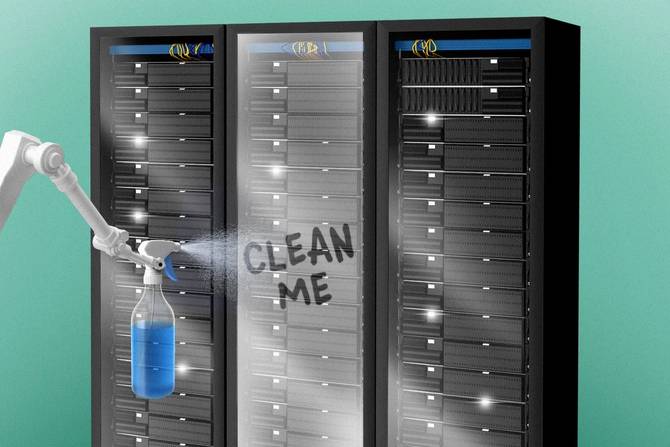Francis Scialabba
While a VMware hypervisor is a complex, hardware-partitioning technology (and not a prop from VR Troopers), the reasons for leaving it unpatched are often frustratingly simple, according to Dan Wiley, chief security advisor at the security provider Check Point Software Technologies: There’s no one there to patch it.
One week after announcements that “ESXiArgs” ransomware was targeting VMware ESXi servers, telemetry from the infosec company Rapid7 found over 18,000 vulnerable internet-facing ESXi servers.
During Check Point’s February CPX 360 event in New York, Wiley revealed one example of forgotten fundamentals: “It is so basic…Why was that still open? And the reason we find is that the person that was responsible for VMware was gone two years ago, and they just didn’t know,” said Wiley.
Transferring patch information can be an organizational challenge, especially with technology like VMware that requires specific expertise. As IT teams add VMware servers to a list of assets that must be updated, pros are adopting tools and processes to ensure patch-management continuity.
“Big corporations, big banks know how to do this really well. They have a really tight life cycle management around it, but small to medium [businesses] struggle around this all day long as they just have the attrition and they don’t have the knowledge transfer from one person to another as things transition,” Wiley told IT Brew.
Read more here.—BH
Do you work in IT or have information about your IT department you want to share? Email [email protected].
|
|
|
It’s hard to keep devices secured when your employees are on all sorts of platforms and logging on to so many apps.
With Kolide, your org can set and enforce policies across your entire fleet—and you can see all they can do in this on-demand demo.
Here’s what to expect. Kolide lets admins:
- enforce OS and browser updates so vulnerable devices can’t access data
- run queries to detect sensitive data
- flag devices that violate sensitive data policies (aka leaving data unencrypted, keeping it too long, or downloading data they shouldn’t)
Kolide makes device compliance part of the authentication process by notifying users about issues during login. And they only allow users to log in after their device is secure. Watch the demo on how to get your fleet to 100% compliance.
|
|
Illustration: Dianna “Mick” McDougall, Source: cienpies/Getty Images
Male and pale. That’s the tech industry’s well-earned reputation for having an overwhelmingly white workforce. Well over half (62%) of tech workers are white, according to Zippia research, and that’s not projected to change substantially.
Some companies are taking steps to address the shortfall, largely through diversity, equity, inclusion, and belonging (DEIB) policies. But those efforts are largely window dressing, according to critics like Per Scholas’s Chief Enterprise Solutions Officer Damien Howard.
Howard, in an interview with IT Brew, detailed what he sees as the problem with implementing DEIB at tech companies and the resistance faced by proponents—as well as the solution.
This conversation has been edited for length and clarity.
Barriers to entry into the tech workforce still exist for people of color and those of marginalized backgrounds in general. What is it about DEIB that isn’t clicking?
I like to focus on workforce, work model, and workplace because it still is a barrier. It’s a barrier, in my opinion, from many conversations that I’ve had with C-suite leaders, because of how it’s perceived. When leaders hear DEIB, they automatically begin to think that there’s something additional that they have to do, instead of just looking at it as a standard best practice for their business and how to move the business forward.
Keep reading here.—EH
Do you work in IT or have information about your IT department you want to share? Email [email protected].
|
|
|
Device secured. It’s simple: If your employees’ devices are out of compliance, Kolide won’t let them access any of your apps. Kolide helps you set and enforce policies across your entire fleet so you can achieve 100% compliance. See what full compliance and complete visibility looks like.
|
|
Francis Scialabba
Today’s top IT reads.
Stat: ~45%. That’s the percentage of the US population that has installed the TikTok app, according to an estimate provided by the company’s CEO, Shou Zi Chew, to Congress. (TechCrunch)
Quote: “It’s important that Google start to play in this space because this is where the world is headed.”—Adrian Aoun, a former director of special projects at Google, on the company’s new AI chatbot, Bard (the New York Times)
Read: Roblox’s new AI program allows developers to enter simple instructions that are then translated into code. (Ars Technica)
|
|
-
Iran’s “cyber army” has seemingly stepped up its efforts in the wake of widespread protests in the country.
-
The EU is warning that ransomware attackers are turning to public transportation and other operational technologies.
-
US chipmaking rules for China-based companies are tightening.
-
ChatGPT helped Claroty’s hacking team win a hackathon.
|
|
Check out the IT Brew stories you may have missed.
|
|
|






